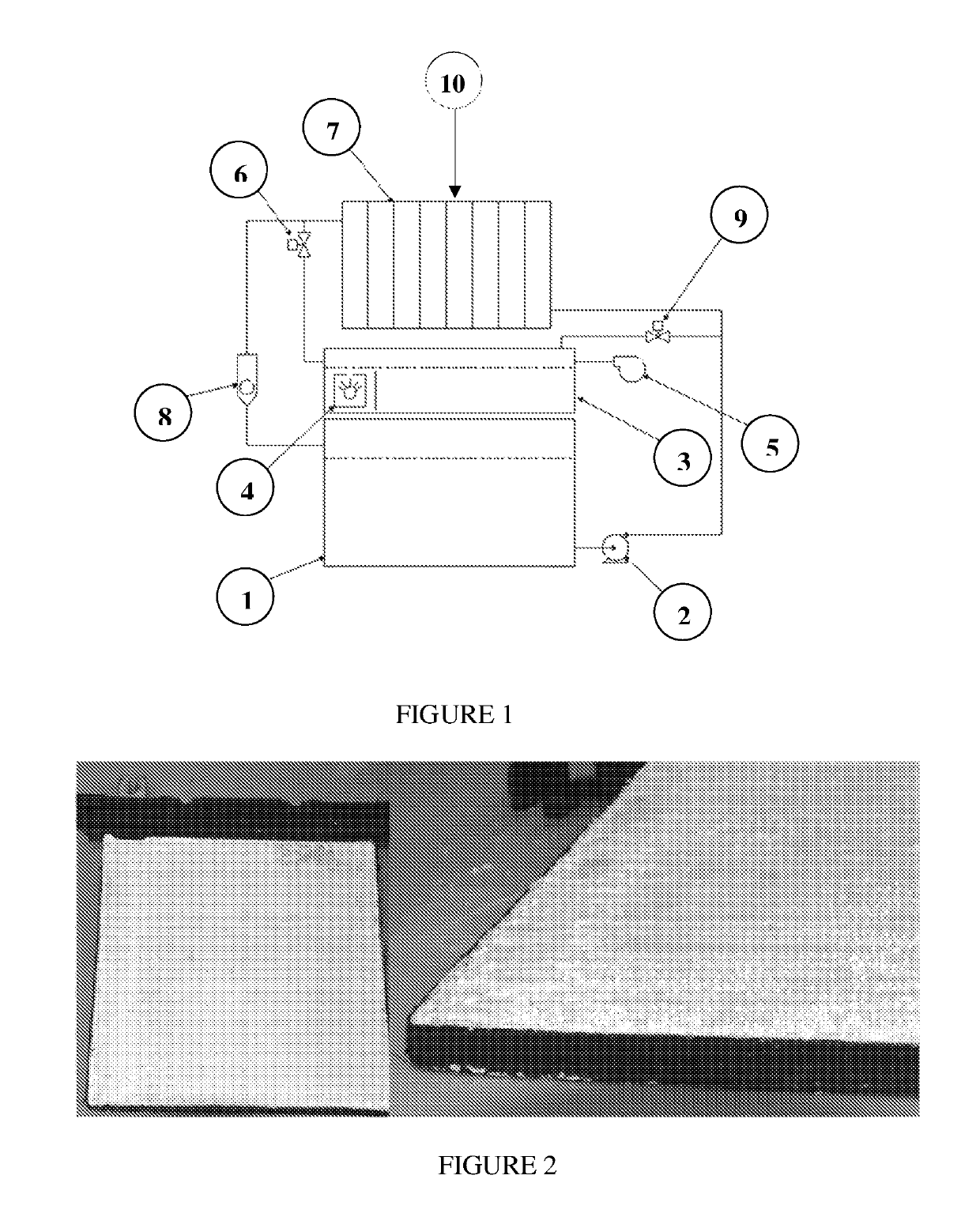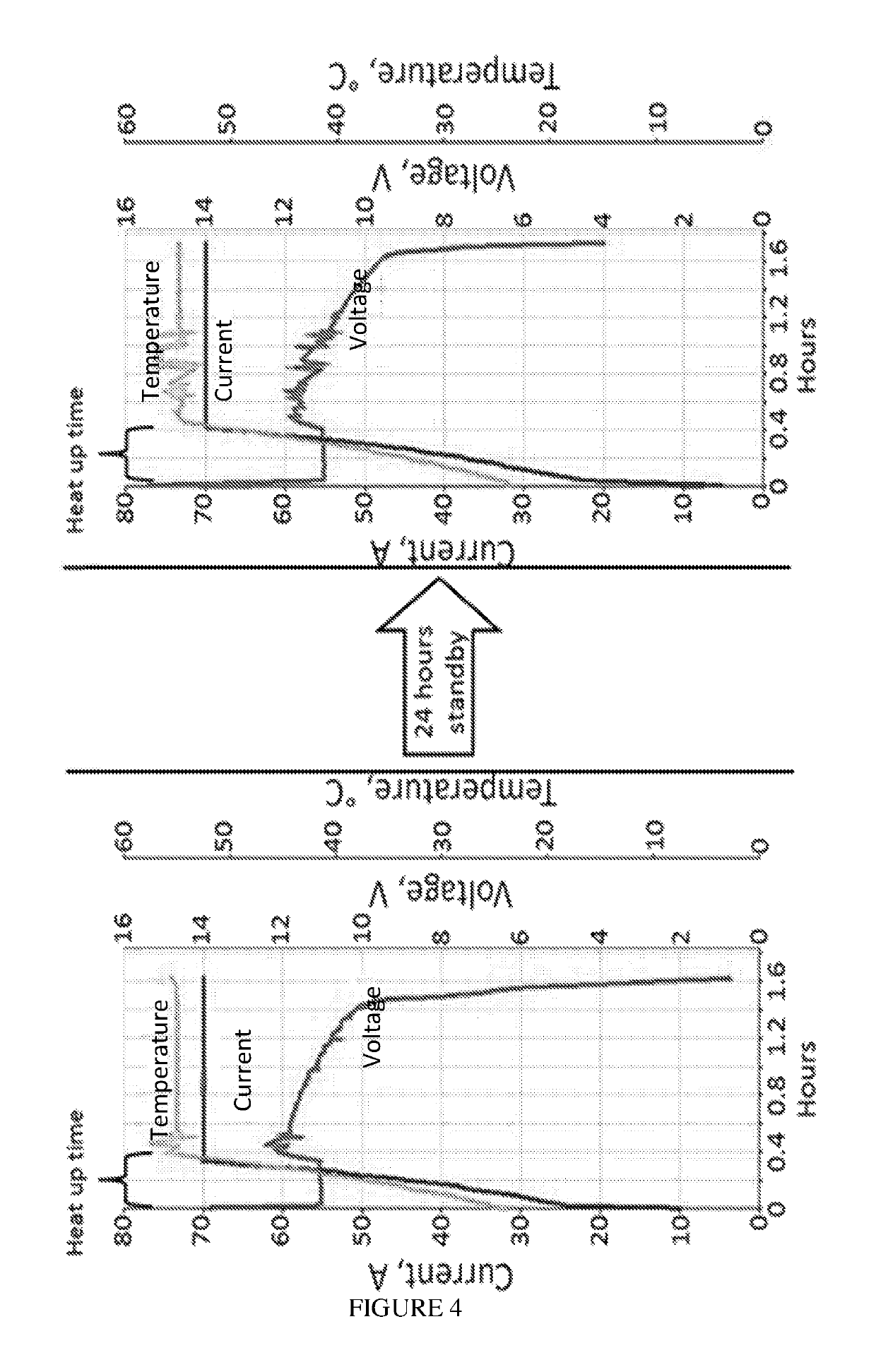Shutdown system for metal-air batteries and methods of use thereof
a technology of battery shutdown and alkaline electrolyte, which is applied in the direction of batteries, primary cell maintenance/service, cleaning using liquids, etc., can solve the problems of aluminum at contact with alkaline electrolyte that is not readily flammable in air atmosphere, is relatively non-expensive, and is susceptible to very intensive corrosion in alkaline electrolyte, so as to prevent, reduce or eliminate environmental hazards, prevent, reduce or eliminate the degradation of the electrode
- Summary
- Abstract
- Description
- Claims
- Application Information
AI Technical Summary
Benefits of technology
Problems solved by technology
Method used
Image
Examples
example 1
Aluminum-Air Battery Operation, Halting, and 96 Hours Standby with No Aerosol Shutdown Treatment
[0206]1 kW aluminum-air battery (10 cells in series, 200 cm2 electrodes cross-section) was filled by electrolyte (comprised mostly of water, 25%-35% w / w potassium hydroxide and 0.1-1% of sodium stannate). Initially, the electrolyte was at room temperature. When electrolyte circulation through the battery started, the electrolyte began to heat-up, and electricity production began as well.
[0207]Standard battery start-up procedure was applied as follows: battery voltage was stabilized at 11V (by applying current via an electronic load). Due to the heat effect of the aluminum-water reaction, the temperature of the electrolyte begins to rise. Electrolyte heating causes, in turn, a rise of electric current, which may be drawn while maintaining the constant voltage 11V. The startup procedure continued until current reached 70 A and the temperature reached 55° C. (measured at the electrolyte outl...
example 2
Aluminum-Air Battery Operation, Halting, and 24 Hours Standby with Aerosol Shutdown Treatment
[0213]1 kW aluminum-air battery was started up, and operated for approximately 2 hours at 55° C., 70 A as described in Example 1 herein above. Following battery operation, the electrolyte was removed from the battery and pumped back to the electrolyte tank.
[0214]Following electrolyte removal, a shutdown procedure was applied as follows:[0215]1. Clean air flow was directed to the battery through the electrolyte circulation pathway. Air flow rate was maintained in the range of 6-10 L / min;[0216]2. Aerosol of phosphoric acid solution was continuously injected through the air inlet into the battery. The aerosol was produced in a small chamber filled with 15% aqueous solution of phosphoric acid. The chamber was equipped with a submerged ultrasonic emitter. The power of the ultrasonic emitter was previously tuned to the value, providing atomization of liquid at a rate 8 ml / min. Aerosol chamber outl...
example 3
Aluminum-Air Battery, Operation, Halting, Aerosol Shutdown Treatment and 24 Hours Standby, Followed by Restart
[0219]1 kW aluminum-air battery was started up, and operated for approximately 2 hours at 55° C., 70 A as described in Example 1. The left graph of FIG. 4 displays battery voltage and current, and electrolyte temperature during the operation. The battery was then shut down using phosphoric acid aerosol treatment as described in Example 2.
[0220]After 24 hours of standby, the battery was filled with fresh electrolyte, restarted and operated at 55° C., 70 A (FIG. 4, right graph).
[0221]Comparing the left and right graphs in FIG. 4, one can see that the applied aerosol shutdown procedure provided proper conservation of the battery. No damage or performance degradation, or any substantial change in heat-up duration occurred during 24 hours of standby. The battery was easily restarted and battery performance was preserved.
PUM
| Property | Measurement | Unit |
|---|---|---|
| inner volume | aaaaa | aaaaa |
| volume | aaaaa | aaaaa |
| voltage | aaaaa | aaaaa |
Abstract
Description
Claims
Application Information
 Login to View More
Login to View More - R&D
- Intellectual Property
- Life Sciences
- Materials
- Tech Scout
- Unparalleled Data Quality
- Higher Quality Content
- 60% Fewer Hallucinations
Browse by: Latest US Patents, China's latest patents, Technical Efficacy Thesaurus, Application Domain, Technology Topic, Popular Technical Reports.
© 2025 PatSnap. All rights reserved.Legal|Privacy policy|Modern Slavery Act Transparency Statement|Sitemap|About US| Contact US: help@patsnap.com



